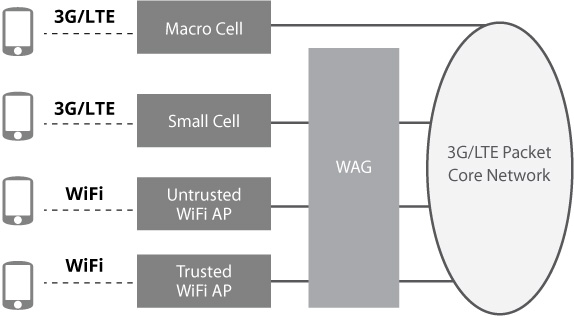Voice over Wi-Fi (VoWi-Fi) refers to the use of IEEE 802.11 wireless LANs (WLANs) to transport Voice over IP (VoIP) traffic. The technology has consumer, business and service provider applications. It is used over private WLANs, home Wi-Fi networks and public Wi-Fi hotspots.
What is Voice over WiFi: Consumer Applications
Historically most consumers have used VoWi-Fi in conjunction with over-the-top (OTT) communications services. Most OTT service providers offer software clients for smartphones, tablets and PCs. Once connected to a home Wi-Fi network or a public Wi-Fi hotspot, an OTT user can place and receive calls to other OTT subscribers or PSTN subscribers. Consumers often use VoWi-Fi and OTT services to avoid mobile network operator (MNO) roaming charges and calling fees.
What is Voice over WiFi: Business Applications
VoWi-Fi is commonly used in business environments. Most enterprise unified communications (UC) solutions support software clients for smartphones, tablets and PCs. Many UC platforms also support Wi-Fi-compatible SIP (session initiation protocol) wireless handsets. Once connected to the corporate WLAN an employee can access PBX features and place and receive calls to coworkers or PSTN subscribers.
What is Voice over WiFi: Service Provider Applications
Mobile network operators are looking to VoWi-Fi to expand network capacity, extend service reach, improve indoor coverage and avoid costly spectrum acquisitions and radio access network (RAN) build-outs. At the same time, many fixed-line service providers and cable multiple-system operators (MSOs) are introducing public hotspots and VoWi-Fi services to compete with MNOs and over-the-top (OTT) service providers.
HetNets
Many mobile network operators are implementing VoWi-Fi as part of Heterogeneous Networks (HetNets) intended to expand RAN coverage and capacity while containing total cost of ownership. A HetNet includes traditional macro cells as well as small cells (femtocells, picocells, metrocells and microcells) and Wi-Fi network elements.
Wi-Fi Hotspot 2.0
The Wi-Fi Alliance Hotspot 2.0 initiative is intended to deliver public Wi-Fi experiences that are as seamless and secure as traditional cellular network interactions. Roaming partners can include MSOs, MNOs, wireline operators, public venues, enterprises, homespots, etc. Traveling users can seamlessly roam on Wi-Fi just like they roam on cellular today.
Wireless Access Gateways
Small cells and public Wi-Fi networks introduce a variety of security challenges for MNOs. Conventional macro RAN architectures are inherently closed and secure. The mobile service provider typically ‘owns’ the mobile base stations and the connectivity to the mobile core. Base station traffic is typically backhauled to the core network over trusted private connections.
Small cells and public Wi-Fi network architectures, by contrast, are inherently open in nature. Small cells and Wi-Fi access points (APs) are deployed in homes, businesses, and public spaces, beyond the control of the mobile network operator. Traffic from small cells and WiFi access points is often backhauled to the mobile core over untrusted public Internet connections.
Wireless Access Gateways (WAGs) are specifically designed to solve these challenges. Best-of-breed WAGs support a wide range of standards-based encryption algorithms, AAA (authentication, authorization, and accounting) mechanisms and tunneling protocols, as well as an integral firewall, Denial of Service (DoS) detection/prevention, and Network Address Translation (NAT) traversal capabilities. They also support seamless roaming (including Hotspot 2.0) and transparent connectivity across Wi-Fi, small cell and cellular networks.


